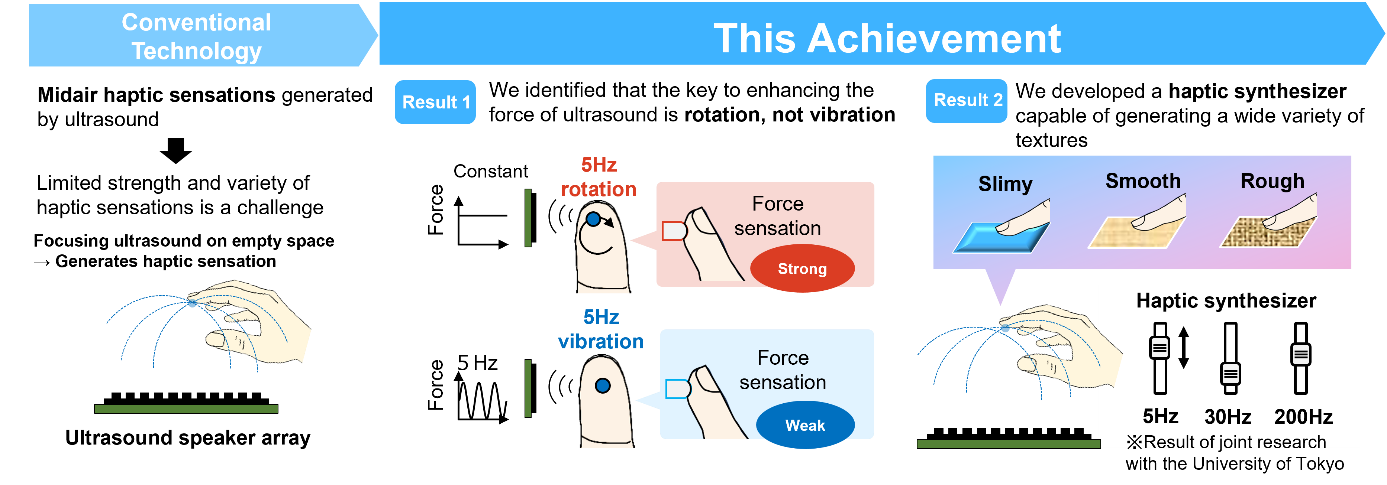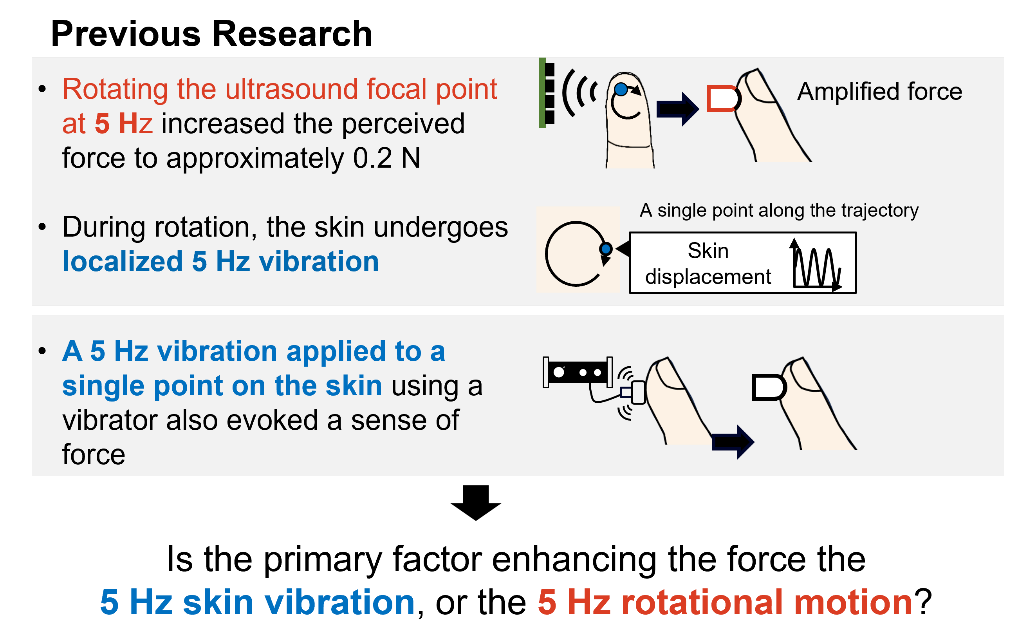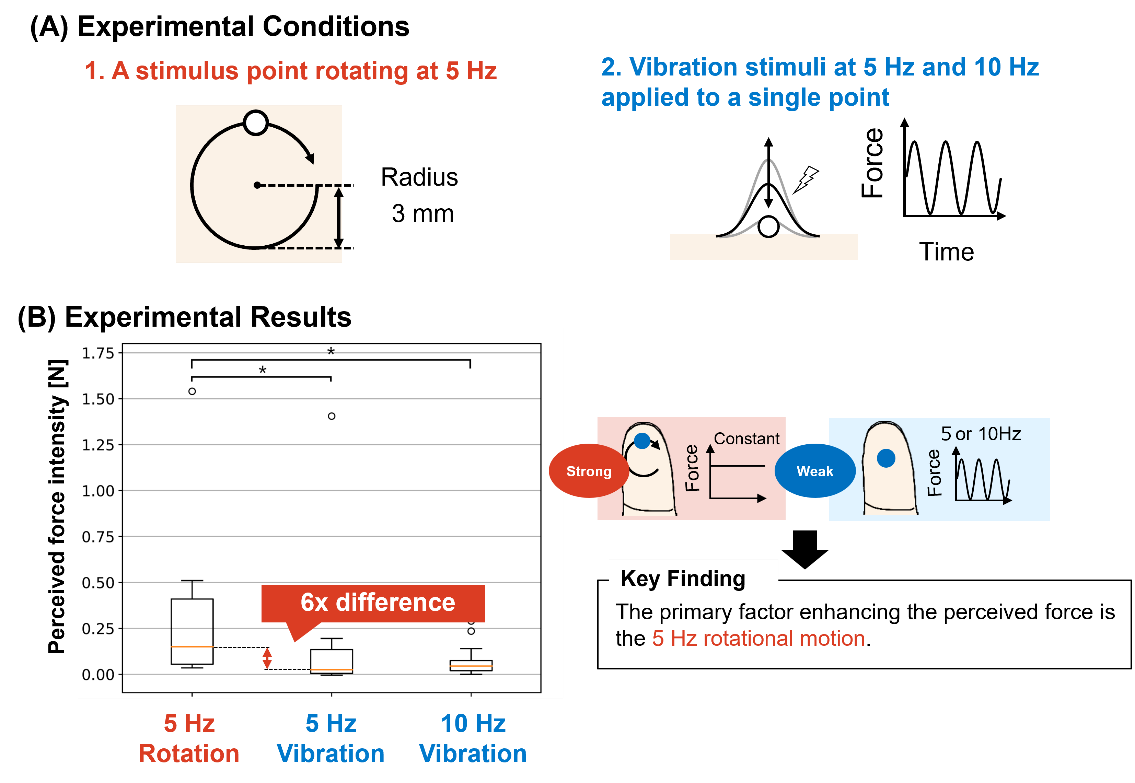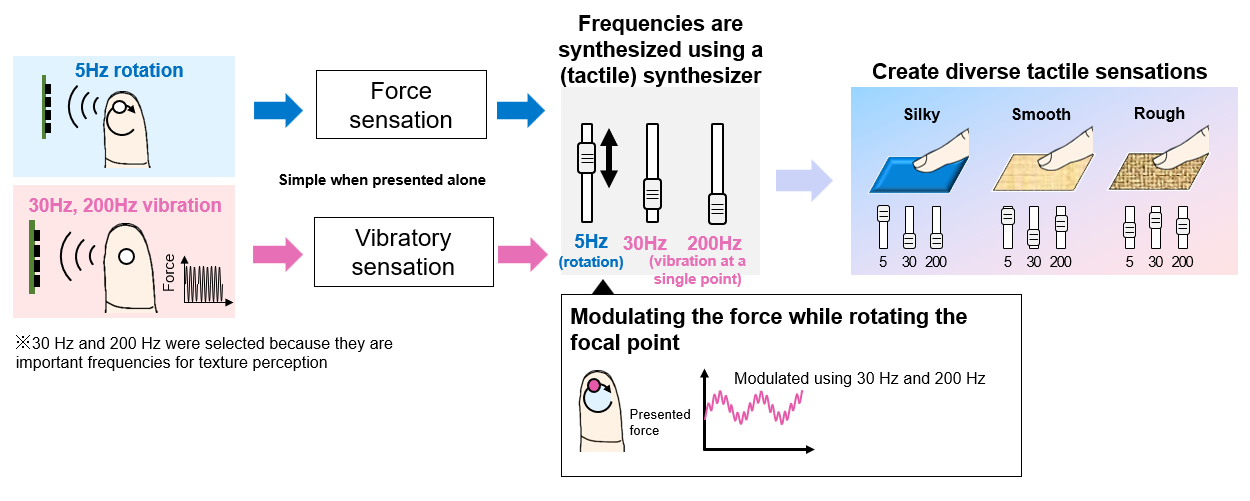Microsoft ends support for Internet Explorer on June 16, 2022.
We recommend using one of the browsers listed below.
- Microsoft Edge(Latest version)
- Mozilla Firefox(Latest version)
- Google Chrome(Latest version)
- Apple Safari(Latest version)
Please contact your browser provider for download and installation instructions.
May 13, 2025
NTT Corporation
Creating Realistic Haptic Sensations in Mid-Air Using Ultrasound--No Wearable Devices Required
Simulating a variety of textures--smooth, rough, and more--without physical contact
News Highlights:
- We have developed a novel technology that creates rich and powerful haptic sensations in midair by focusing ultrasound on the skin and adding vibrations at specific frequencies.
- While conventional ultrasound haptics could only produce weak and simple haptic sensations, our research is the first in the world to discover that incorporating motion into ultrasound can generate much stronger force sensations.
- This new technology eliminates the need for users to wear any devices, paving the way for immersive XR experiences with realistic and dynamic haptic feedback and minimal user burden.
TOKYO - May 13, 2025 - NTT Corporation (Headquarters: Chiyoda, Tokyo; President and CEO: Akira Shimada; hereinafter "NTT") has developed a new technology that delivers rich and powerful haptic sensations in midair by focusing ultrasound on the skin and adding vibrations at specific frequencies. Part of this achievement is the result of collaborative research with The University of Tokyo.
When ultrasound is focused onto the skin, it creates a non-contact haptic sensation at the focal point. Because this ultrasound haptic technology requires no wearable devices, it has attracted attention as a low-burden solution for users.
In this research, we identified the stimulation conditions that enhance the sense of force generated by ultrasound. Furthermore, we developed an midair haptic synthesizer capable of freely combining multiple frequency vibration stimuli presented by ultrasound to generate a wide range of haptic textures.
By advancing this technology, we aim to contribute to achieve realistic XR experiences that provide divers haptic sensations without the need for wearable devices.
This research was presented at the international conference on haptics, Eurohaptics conference 2024, where it has been nominated for the Best Paper Award and the Best Demonstration Award. We also exhibited it at the Open House 2025 of the NTT Communication Science Laboratories, starting May 20.
Background
At NTT Communication Science Laboratories, we are engaged in basic research in human sciences, with a focus on deeply understanding the human experience.
To date, we have uncovered key mechanisms behind human visual and haptic perception, and based on those findings, have developed the world's first high-quality sensory experiences [1], [2].
One of our goals is to develop technologies capable of conveying the sensation of touch—such as contact with people or objects—to users. This holds promise for highly immersive XR experiences and even remote interpersonal interaction. However, achieving this level of realism has traditionally required the use of heavy wearable devices, limiting practical applications.
To address this challenge, research has been advancing into non-contact haptic presentation using ultrasound. This technology focuses ultrasound onto a small area of the skin to create haptic sensations without any physical contact. By concentrating ultrasound energy at a focal point, it becomes possible to simulate touch in midair.
However, conventional ultrasound haptic technology face two major limitations: the force they can deliver is weak, and the types of haptic sensations they can produce are limited and monotonous.
In response, we have now developed a new ultrasound presentation technology capable of generating a wide variety of non-contact haptic sensations (Figure 1). This breakthrough represents a significant step toward delivering rich and realistic touch experiences in XR environments.
 Figure 1 Overview of the Research Results
Figure 1 Overview of the Research Results
Note. We developed a novel ultrasonic technology that generates strong and diverse haptic sensations in mid-air without physical contact.
(Result 1) We identified that rotation, not vibration, is the key stimulation condition for enhancing the force sensation evoked by focused ultrasound.
(Result 2) We constructed a haptic synthesizer capable of combining multiple frequency vibration stimuli and adjusting their intensities, allowing for the creation of diverse haptic textures such as slimy, smooth, and rough sensations.
This technology has the potential to enable future applications such as remote social touch and immersive haptic experiences in XR environments.
Summary of Findings
We addressed these challenges through two separate studies conducted in this research.
In the first, we investigated the conditions necessary to enhance the sensation of force produced by ultrasound. While previous studies have sought ways to increase perceived force, the key factor behind this enhancement had not been clearly identified. For the first time, we found that rotating the ultrasound focal point at 5 Hz is the critical element responsible for amplifying the perceived force. In the second study, we used this key finding to develop an ultrasound haptic synthesizer capable of generating a variety of haptic sensations. In everyday life, people perceive a rich range of textures by integrating haptic stimuli of various frequencies on the skin. Inspired by this mechanism, we devised a new approach that synthesizes multiple frequency vibrations stimuli by ultrasound to create diverse haptic sensations without physical contact.
(1) Identifying the Key Factor That Enhances Ultrasound Force Sensation
Typically, when a person touches an ultrasound focal point, they perceive only a weak force—usually around 0.01 newtons1. However, when this focal point is rotated across the skin at a frequency of 5 Hz, the perceived force increases by up to twentyfold. This type of rotational stimulation involves multiple elements, including skin vibrations that match the rotation frequency and a broader area of stimulation. Despite this, previous studies had not determined which specific factor was primarily responsible for enhancing the sensation of force (Figure 2).
In this study, we focused on the 5 Hz vibration that appears on the skin produced by rotating an ultrasound focal point.
 Figure 2 Positioning of Result 1
Figure 2 Positioning of Result 1
Note. It was previously known that rotating an ultrasound focal point at 5 Hz increases the perceived force. However, because rotational stimulation includes multiple components—such as vibrations on the skin and an expanded stimulation area —the specific factor responsible for enhancing the sensation of force remained unclear. In this study, we investigated whether the main contributor was the 5 Hz skin vibration or the rotational movement itself.
It has been observed that 5 Hz vibrations occur locally at each point along the rotation path. In addition, earlier research demonstrated that applying a 5 Hz vibration to a single point on the skin using a mechanical actuator can also produce a distinct sensation of force. This raised the question of whether the enhanced sensation associated with the rotating focal point was due to the rotational movement itself or to the resulting skin vibration at 5 Hz.
To identify the main contributing factor, we designed two types of ultrasound stimuli. In the first, a focal point of constant intensity was rotated at 5 Hz across the skin. In the second, the intensity of a stationary focal point was modulated between zero and its maximum value at 5 Hz to create a vibration-like effect (Figure 3). Participants received the ultrasound stimulus on their left hand, while their right hand was presented with a mechanical pressing force generated by a robotic arm. By comparing the sensations on both hands, we quantified the strength of the force perceived from each ultrasonic condition.
 Figure 3 (A) Ultrasound Stimuli Used in the Experiment. (B) Experimental Results
Figure 3 (A) Ultrasound Stimuli Used in the Experiment. (B) Experimental Results
Note. It was found that 5 Hz rotational stimulation produces a stronger sensation of force than 5 Hz or 10 Hz vibration applied to a single point.
The results revealed that the 5 Hz rotational stimulus evoked a sensation of force six times stronger than the 5 Hz vibration stimulus. This finding clearly indicates that the rotational motion at 5 Hz is the primary factor responsible for amplifying the perceived force. Our results contribute to the development of next-generation ultrasound-based haptic technologies capable of delivering stronger and more realistic sensations. This research was presented at the Eurohaptics conference 2024 and was nominated for the Best Paper Award.
(2) Ultrasound Haptic Synthesizer for Generating Diverse Haptic Sensations Using Modulated Acoustic Pressure
Humans perceive the haptic qualities of various objects through skin stimulation involving a wide range of frequencies. In this study, we focused on three key frequencies—5 Hz, 30 Hz, and 200 Hz—which are known to effectively stimulate mechanotactile receptors [3]. We developed a new ultrasound haptic synthesizer that combines these frequencies to generate a variety of haptic sensations (Figure 4).
Based on the findings of Study (1), we first present a rotating ultrasonic focal point at 5 Hz to produce a strong sense of force. Then, we modulate the intensity of this rotating focal point using 30 Hz and 200 Hz signals, effectively creating a vibration on the skin. The strength of the perceived vibration is determined by the amplitude of the modulation applied to the acoustic pressure. These three frequency bands are synthesized and projected onto the user's skin simultaneously.
Using this technique, users can experience a wide range of haptic sensations. The 5 Hz rotation reproduces the sensation of static contact with an object, while the combination of 30 Hz and 200 Hz reproduces vibration sensations felt when stroking different material textures. As a result, sensations such as slimy, smooth, and rough textures can be finely tuned and freely generated.
This research was presented at the Eurohaptics conference 2024, where it was nominated for the Best Demonstration Award. The study was conducted in collaboration with The University of Tokyo.
 Figure 4 Haptic Synthesizer Developed in Result 2
Figure 4 Haptic Synthesizer Developed in Result 2
Note. By rotating the ultrasound focal point while modulating its output force, multiple frequencies are synthesized. By adjusting the intensity ratio of these frequencies, a wide range of haptic sensations can be created.
Outlook
In this study, we developed a novel technology that delivers strong and varied haptic sensations by adding rotational motion and specific-frequency vibrations to ultrasound force. Building on these findings, we aim to create haptic interfaces and content that allow users to experience realistic sensations—such as remote social touch or immersive interactions in XR environments—without the need to wear any physical devices.
Going forward, we will work toward faithfully reproducing the haptic sensations that people feel when touching various real-world objects. We will also deepen our understanding of the mechanisms that enhance perceived force and further explore how the human brain processes and perceives haptic information. Through these efforts, we hope to contribute to the realization of the world's first truly immersive haptic experiences in XR.
[Conference Presentation]
Result 1
Conference Name: Eurohaptics conference 2024
Title: Towards Intensifying Perceived Pressure in Midair Haptics: Comparing Perceived Pressure Intensity and Skin Displacement between LM and AM Stimuli
Authors: Tao Morisaki and Yusuke Ujitoko
DOI: https://link.springer.com/chapter/10.1007/978-3-031-70058-3_9
Result 2
Conference Name: Eurohaptics conference 2024
Title: Midair 3D Texture Display Using Focused Ultrasound Based on Superimposing Pressure Sensation and Vibration Sensation
Authors: Tao Morisaki, Yasutoshi Makino and Hiroyuki Shinoda
[Reference]
[1].Press release: "Discovery of a New Haptic Illusion: Perceived Speed Varies Despite Constant Actual Speed"
https://group.ntt/en/newsrelease/2025/03/19/250319b.html
[2].Press release: "World's first: A display system to present a large-scale 3D aerial image beyond the frame of multiple monitors using illusion"
https://group.ntt/en/newsrelease/2024/06/17/240617d.html
[3].S. J. Bolanowski et. al., "Four channels mediate the mechanical aspects of touch," The Journal of the Acoustical Society of America, 1988.
[Glossary]
1.One newton (1 N) is approximately equivalent to the force required to support a mass of 100 grams.
About NTT
NTT contributes to a sustainable society through the power of innovation. We are a leading global technology company providing services to consumers and businesses as a mobile operator, infrastructure, networks, applications, and consulting provider. Our offerings include digital business consulting, managed application services, workplace and cloud solutions, data center and edge computing, all supported by our deep global industry expertise. We are over $92B in revenue and 330,000 employees, with $3.6B in annual R&D investments. Our operations span across 80+ countries and regions, allowing us to serve clients in over 190 of them. We serve over 75% of Fortune Global 100 companies, thousands of other enterprise and government clients and millions of consumers.
Media contact
NTT Science and Core Technology Laboratory Group
Public Relations
Inquiry Form
Information is current as of the date of issue of the individual press release.
Please be advised that information may be outdated after that point.
NTT STORY
WEB media that thinks about the future with NTT










